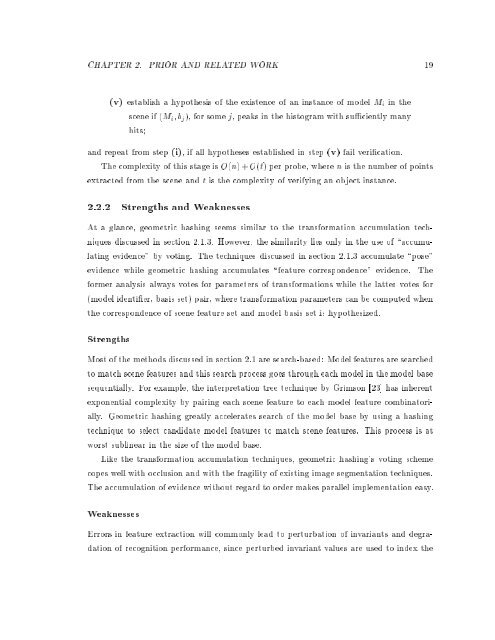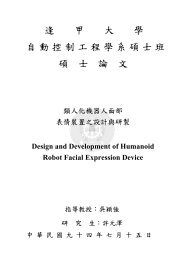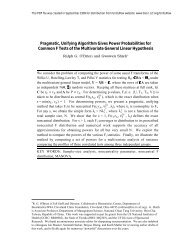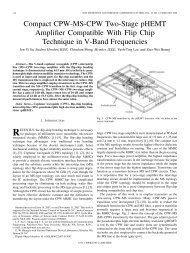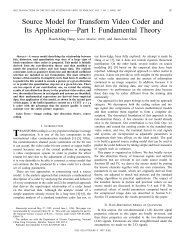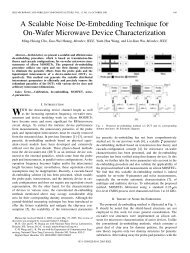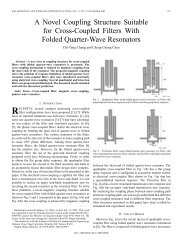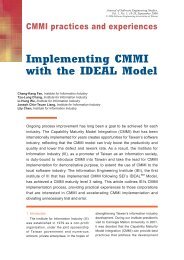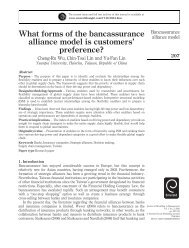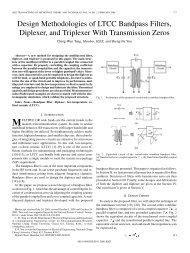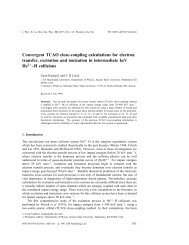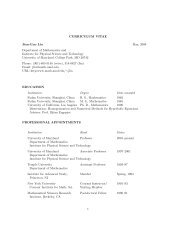A Probabilistic Approach to Geometric Hashing using Line Features
A Probabilistic Approach to Geometric Hashing using Line Features
A Probabilistic Approach to Geometric Hashing using Line Features
Create successful ePaper yourself
Turn your PDF publications into a flip-book with our unique Google optimized e-Paper software.
CHAPTER 2. PRIOR AND RELATED WORK 19<br />
èvè establish a hypothesis of the existence of an instance of model M i<br />
in the<br />
scene if èM i ;b j è, for some j, peaks in the his<strong>to</strong>gram with suæciently many<br />
hits;<br />
and repeat from step èiè, if all hypotheses established in step èvè fail veriæcation.<br />
The complexity of this stage is Oènè+Oètè per probe, where n is the number of points<br />
extracted from the scene and t is the complexity ofverifying an object instance.<br />
2.2.2 Strengths and Weaknesses<br />
At a glance, geometric hashing seems similar <strong>to</strong> the transformation accumulation techniques<br />
discussed in section 2.1.3. However, the similarity lies only in the use of ëaccumulating<br />
evidence" by voting. The techniques discussed in section 2.1.3 accumulate ëpose"<br />
evidence while geometric hashing accumulates ëfeature correspondence" evidence. The<br />
former analysis always votes for parameters of transformations while the latter votes for<br />
èmodel identiæer, basis setè pair, where transformation parameters can be computed when<br />
the correspondence of scene feature set and model basis set is hypothesized.<br />
Strengths<br />
Most of the methods discussed in section 2.1 are search-based: Model features are searched<br />
<strong>to</strong> match scene features and this search process goes through each model in the model base<br />
sequentially. For example, the interpretation tree technique by Grimson ë23ë has inherent<br />
exponential complexity by pairing each scene feature <strong>to</strong> each model feature combina<strong>to</strong>rially.<br />
<strong>Geometric</strong> hashing greatly accelerates search of the model base by <strong>using</strong> a hashing<br />
technique <strong>to</strong> select candidate model features <strong>to</strong> match scene features. This process is at<br />
worst sublinear in the size of the model base.<br />
Like the transformation accumulation techniques, geometric hashing's voting scheme<br />
copes well with occlusion and with the fragility of existing image segmentation techniques.<br />
The accumulation of evidence without regard <strong>to</strong> order makes parallel implementation easy.<br />
Weaknesses<br />
Errors in feature extraction will commonly lead <strong>to</strong> perturbation of invariants and degradation<br />
of recognition performance, since perturbed invariant values are used <strong>to</strong> index the


